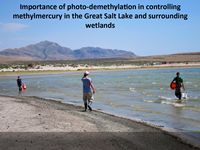2014 Research Catalyst Grantee

Frank Black
Westminster College
Project Title
Identifying options for the adaptive management of wetlands to minimize the net production and export of monomethylmercury
Abstract
The Great Salt Lake is surrounded by roughly 400,000 acres of freshwater and brackish wetlands. These wetlands are hotspots for the production of monomethylmercury (MMHg), a potent neurotoxin and environmental pollutant found at very high concentrations in the Great Salt Lake that pose a health risk to both wildlife and humans. While many of these wetlands are already heavily managed, wetland managers currently lack the information required to develop adaptive management plans in order to reduce or mitigate the production and export of MMHg from the wetlands. In many cases, such strategies would be consistent with the current goals of wetland management, such as to provide desirable wildlife habitat.
We will conduct research on two aspects of the biogeochemical cycling of mercury in the wetlands along the borders of the Great Salt Lake with the goal of identifying water management strategies that will reduce MMHg production and export from these wetlands to adjacent surface waters. The first research area will focus on limiting microbial production of MMHg in wetland sediments by controlling the timing and duration of flood-up and dry-down each year. This research will use a mesocosm approach. The second research area will focus on maximizing photo-degradation of MMHg in wetland surface waters before it can be transported to adjacent aquatic ecosystems. This research will use bottle incubation experiments to identify the factors controlling this abiotic process and the reaction mechanisms involved. This will allow us to model MMHg photo-degradation under various chemical and physical conditions that can be controlled in different managed wetlands. Lastly, the novel use of stable mercury isotopic ratios will be used to both quantify the role of wetlands vs. the deep brine layer as the source of MMHg in surface waters of the GSL (using unique isotopic signatures of even Hg isotopes), and evaluate the importance of MMHg photo-degradation in surface waters (using mass independent fraction of odd Hg isotopes) as a means to corroborate results from the photo-degradation bottle experiments.
This interdisciplinary project will strengthen research collaborations between researchers and students at Westminster College and the University of Utah. The proposed research directly addresses issues related to the management of Utah’s water resources and the interactions between humans and aquatic ecosystems in the state, which are at the core of the iUTAH initiative.
Collaborator
William Johnson, The University of Utah
Presentation
Importance of photo‐demethylation in controlling methylmercury in the Great Salt Lake and surrounding
wetlands

Presented: July 17, 2015


